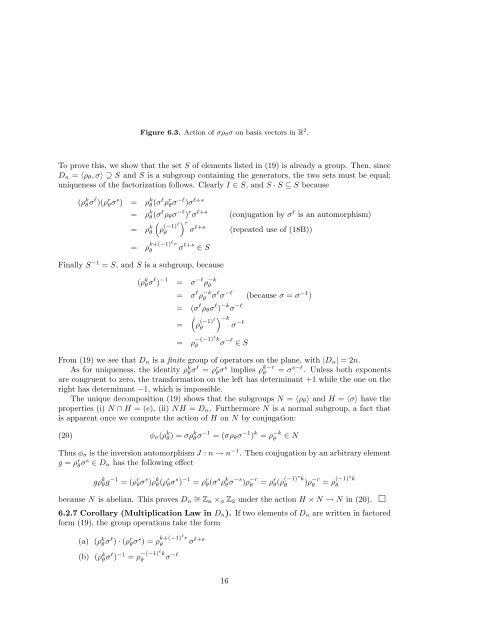Algebra I: Section 6. The structure of groups. 6.1 Direct products of ...
Algebra I: Section 6. The structure of groups. 6.1 Direct products of ...
Algebra I: Section 6. The structure of groups. 6.1 Direct products of ...
Create successful ePaper yourself
Turn your PDF publications into a flip-book with our unique Google optimized e-Paper software.
Figure <strong>6.</strong>3. Action <strong>of</strong> σρθσ on basis vectors in R 2 .<br />
To prove this, we show that the set S <strong>of</strong> elements listed in (19) is already a group. <strong>The</strong>n, since<br />
Dn = 〈ρθ, σ〉 ⊇ S and S is a subgroup containing the generators, the two sets must be equal;<br />
uniqueness <strong>of</strong> the factorization follows. Clearly I ∈ S, and S · S ⊆ S because<br />
(ρ k θ σℓ )(ρ r θ σs ) = ρ k θ (σℓ ρ r θ σ−ℓ )σ ℓ+s<br />
= ρ k θ(σ ℓ ρθσ −ℓ ) r σ ℓ+s<br />
� �r σ ℓ+s<br />
= ρ k θ<br />
ρ (−1)ℓ<br />
θ<br />
= ρ k+(−1)ℓr θ σ ℓ+s ∈ S<br />
Finally S −1 = S, and S is a subgroup, because<br />
(ρ k θσ ℓ ) −1 = σ −ℓ ρ −k<br />
θ<br />
= σ ℓ ρ −k<br />
θ σℓ σ −ℓ<br />
= (σ ℓ ρθσ ℓ ) −k σ −ℓ<br />
=<br />
�<br />
ρ (−1)ℓ<br />
θ<br />
(conjugation by σ ℓ is an automorphism)<br />
(repeated use <strong>of</strong> (18B))<br />
� −k<br />
σ −ℓ<br />
= ρ −(−1)ℓk θ σ −ℓ ∈ S<br />
(because σ = σ −1 )<br />
From (19) we see that Dn is a finite group <strong>of</strong> operators on the plane, with |Dn| = 2n.<br />
As for uniqueness, the identity ρk θσℓ = ρr θσs implies ρ k−r<br />
θ = σs−ℓ . Unless both exponents<br />
are congruent to zero, the transformation on the left has determinant +1 while the one on the<br />
right has determinant −1, which is impossible.<br />
<strong>The</strong> unique decomposition (19) shows that the sub<strong>groups</strong> N = 〈ρθ〉 and H = 〈σ〉 have the<br />
properties (i) N ∩ H = (e), (ii) NH = Dn. Furthermore N is a normal subgroup, a fact that<br />
is apparent once we compute the action <strong>of</strong> H on N by conjugation:<br />
(20) φσ(ρ k θ ) = σρk θ σ−1 = (σρθσ −1 ) k = ρ −k<br />
θ<br />
Thus φσ is the inversion automorphism J : n → n −1 . <strong>The</strong>n conjugation by an arbitrary element<br />
g = ρ r θ σs ∈ Dn has the following effect<br />
∈ N<br />
gρ k θg−1 = (ρ r θσs )ρ k θ (ρrθ σs ) −1 = ρ r θ (σsρ k θσ−s )ρ −r<br />
θ = ρrθ (ρ(−1)s k<br />
θ )ρ −r<br />
θ = ρ(−1)s k<br />
θ<br />
because N is abelian. This proves Dn ∼ = Zn ×φ Z2 under the action H × N → N in (20). �<br />
<strong>6.</strong>2.7 Corollary (Multiplication Law in Dn). If two elements <strong>of</strong> Dn are written in factored<br />
form (19), the group operations take the form<br />
(a) (ρk θσℓ ) · (ρr θσs ) = ρ k+(−1)ℓr θ σℓ+s (b) (ρk θσℓ ) −1 = ρ −(−1)ℓk θ σ−ℓ 16

















